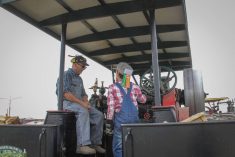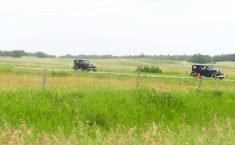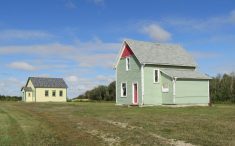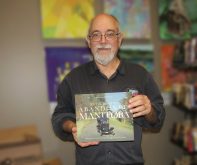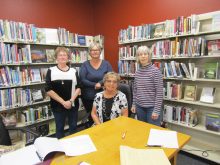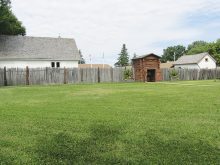Fall is a season of transition, a reminder of the value of change, in this case from bright, buzzing, verdant summer toward the dark, quiet calm of winter.
The journey can be experiential and intellectual, no matter the trip, but it’s more relaxing deep within a national park.
It’s not every day, an invitation is extended to be a part of something, which holds more value than simply a club’s year-end windup. Tagging along with members, parents, and friends of the Riding Mountain Wranglers 4-H Club, the day was uplifting, sharing conversation from the back of a horse-drawn wagon, experiencing trails carved out within Riding Mountain National Park (RMNP) and learning more about the history of the escarpment from a well- spoken trail guide.
Read Also

Seeding Indigenous agricultural prosperity
National Circle for Indigenous Agriculture and Food says Indigenous agricultural success needs strong relationships.
Thanks to club leader, Karen Bergeson of Rossburn, who spent some 35 years within RMNP, along with her late husband and park ranger, Gordon, it was a refreshing seven-hour excursion to the location of the Whitewater Prisoner of War (PoW) camp and back to the parking lot just off the Bison Enclosure, home of approximately 30 plains bison, near Lake Audy.
“City folk are excited to experience RMNP, but often it’s nothing more than a visit to Clear Lake,” commented Bergeson. “One has to venture deep into the park to enjoy the richness of the trees, vegetation, creeks, lakes, wildlife, trails, and to experience first hand what the park truly offers.”
The 10.1-km distance to the location of the former PoW camp didn’t truly seem that long as draft horses, King and Daisy, owned and driven by Richard Grudeski of Vista walked or trotted along the route known as Centre Trail. Prior to the construction of Highway 10 this was the main link from one side of the park to the other. With a length of 73 km (one way, from the Bison Enclosure to Deep Lake Warden Station), the level of difficulty is moderate, and in regard to facilities there are three campsites on Central Trail, and six campsites on adjoining trails including some accessible solely by foot or non-motor bikes, as was experienced that day.
Used from October 1943 to October 1945, Whitewater camp held 450 German Afrika Korps soldiers captured in Egypt during the Second World War. These men were sent from larger camps in Medicine Hat and Lethbridge, Alta., which were part of a larger PoW camp system in Canada during the Second World War. This information forms a part of a display including how the camp was set up back in the day at the site. Visitors also can listen to recorded stories, simply by cranking a dial.

Originally the German prisoners were to have been placed along the south shore of Lake Audy at the site of a former National Forestry Program Camp. But it was pointed out by the park superintendent that there would be more work for the men if the camp was built along the north shore of Whitewater Lake near a fire-damaged stand of poplar, which was likely to yield 200,000 cords of wood.
Constructed at an estimated cost of over $300,000, the camp featured six large bunkhouses, each with its own washroom and shower facilities, a large cookhouse and dining room, a combination garage and workshop, hospital, a large commissary store, staff quarters, a barn, and even a camp power plant.
The camp had no fence or guard towers. The boundaries of the camp were designated by blazes on a ring of outlying trees. Beyond that, there was nothing but mile after mile of wilderness.
Authorities believed that the camp’s location, in the heart of the park, would discourage the prisoners from trying to escape. However, a few did, thanks to constructing canoes from wood sources, and rowing across the lake to Olha for cards, conversation and companionship with settlers, especially women.
They would visit the small immigrant communities along the southern boundary of the park and then head back to camp before rollcall the next morning.
Apparently, the Germans were favoured guests at local dances and parties because they carried with them rationed goods, especially sugar for the local stills. Local farmers with sleighs routinely picked up the men at the park boundary and gave them a change of clothing.
The Germans, meanwhile, always used the same excuse for their absence – they had simply gone for a hike and become lost. They realized that any mass escape attempt would mean an end to their Whitewater days and immediate shipment to a maximum-security facility.
A portion of my history lesson came via the book Park Prisoners – The Untold Story of Western Canada’s National Parks, 1915 – 1946 by author Bill Waiser, while waiting for a campfire to burn down.
Although no wildlife was spotted, acquaintances at the Minnedosa River camp stated they saw moose, elk, and heard wolves the night previous. But the pleasure of the piercing sound and closeness of the Canada jay, also known as the gray jay, the beauty of spruce and tamarack, and the serenity of an artistic landscape, was fulfilment.
Other people on the trek were horseback riders, Roseann Yaremchuk and her son Dillon, Alicia Grassinger and her daughter Faith, all of Rossburn, and Sydney Gerelus, who was joined by her Shoal Lake parents, Larry and Carol, and Gill Grudeski of Vista. Additional club members and fellow high point winners on the year not present were Paige Swain of Shoal Lake, Robyn Yaremchuk of Rossburn, and Nicole Shaw of Birtle.
Singing with life, Riding Mountain National Park is home to a staggering diversity of living things. Enjoy it as you find it, but always honour, acknowledge, and recognize Indigenous contributions to the park, and the province, as the forested parkland in Treaty 2 Territory, stands in sharp contrast to the surrounding prairie farmland.



